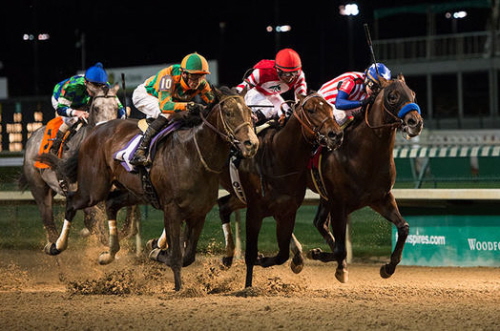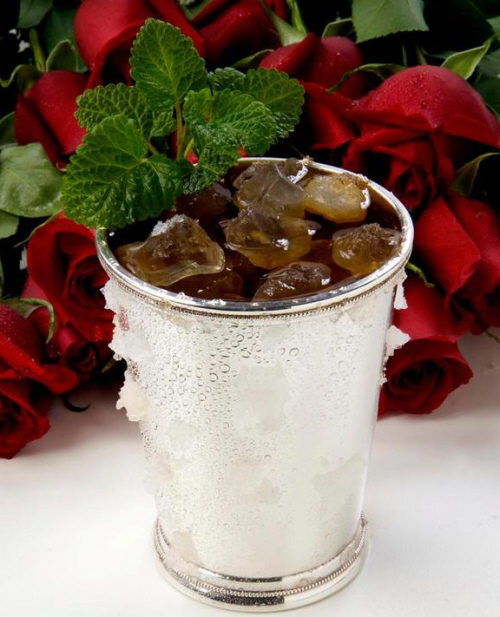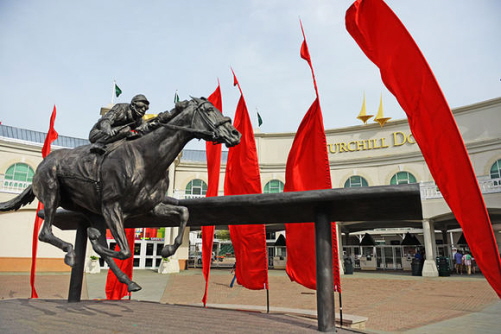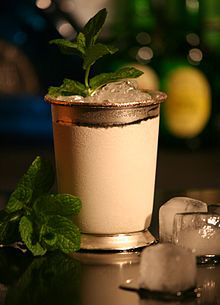 When the Kentucky Derby runs this Saturday, the horses won’t be the only ones racing. Over at the Seelbach Hotel, the mint juleps will be flying too.
When the Kentucky Derby runs this Saturday, the horses won’t be the only ones racing. Over at the Seelbach Hotel, the mint juleps will be flying too.
By the end of the day, the hotel staff and its bartender, Edward Duffy, will have concocted more than 3,000 of these traditional cocktails made with bourbon and fresh mint hand-picked from the hotel grounds.
Built in 1905, the Seelbach Hotel was F. Scott Fitzgerald’s favorite watering hole—and it was also his setting for the wedding of Daisy and Tom Buchanan in his novel The Great Gatsby.
But today, amid the creaking bar stools, clinking glasses and cigar-roughened laughter, the talk is all, “Who did ya bet?” and “Gimme another julep.”
 Since 1875 in this town of Louisville, small men have raced large thoroughbreds on the first Saturday of May. The event, known as “the greatest two minutes in sport,” is celebrated by the heaviest ten hours of drinking.
Since 1875 in this town of Louisville, small men have raced large thoroughbreds on the first Saturday of May. The event, known as “the greatest two minutes in sport,” is celebrated by the heaviest ten hours of drinking.
More than 150,000 people are expected to attend the Derby, including politicians, celebrities, millionaires and royalty.
This year, George Steinbrenner, Lee Ann Womack, Robert Kennedy Jr., Joan Rivers, Dennis Hopper, Anjelica Huston, Francis Ford Coppola, John Travolta, Matt Damon and Prince Albert of Monaco will all likely be there.
These luminaries, along with the groupies, gamblers and beautiful losers, will start drinking early in the afternoon and continue until well past the 6 p.m. race.
The mint julep is as closely tied to the Run for the Roses as champagne is to Wimbledon. Around the outside of the Churchill Downs track, hundreds of men and women will scramble to make and serve 80,000 mint juleps today: they’ll use 1,700 gallons of bourbon, 600 gallons of syrup, 80 tons of snow ice and 84,000 sprigs of mint.
The cocktail is pure Scarlet O’Hara: sweet and light aromas lure you in, and then a hellfire finish screams down your throat. Toss back more than a couple of these steel magnolias, and you’ll be the blinkered one running in circles in front of the grandstand.
A mint julep, after all, is just gussied-up bourbon—the bow-tie bourbon of the gentleman scoundrel. Bourbon straight up has long been considered the drink of dark-stubbled men with twitchy trigger fingers, and hard-boiled detectives who kept friendship in a drawer.
A spirit considered “too mean to drink,” bourbon is still viewed as America’s most manly swallow—one that hankers for a good woman to understand it.
 It was the Reverend Elijah Craig who first discovered bourbon back in 1789. As the story goes, Craig stored some corn whiskey in barrels that had been charred in a barn fire.
It was the Reverend Elijah Craig who first discovered bourbon back in 1789. As the story goes, Craig stored some corn whiskey in barrels that had been charred in a barn fire.
When he finally drank the contents, he found that the burnt wood had tamed the rawhide spirit and given it some sweet caramel flavors. Soon distilleries were spreading faster than blue grass on the hills: more than 700 in Kentucky alone.
For 150 years these operations prospered—until the 1930s, when Prohibition did most of them in.
Today, about ten distilleries produce 200 labels, with names like those of the gunslingers and gold miners in a grainy old black-and-white Western: Jim Beam, Maker’s Mark, Booker’s, Old Grand-Dad, Fighting Cock, Old Forester and Old Crow.
But what’s vexing is that, in most of the counties where bourbon is made, you can’t buy it. Almost 70 years after Prohibition ended, 90 of 120 counties in this Bible-belt state are still dry.
Even the tasters who work at the distilleries must get permission slips from their mothers, spouses and parish priests, promising that they have the moral fortitude not to swallow.
It’s enough to drive the tasters to drink—or else to get real crafty: they’ve invented a technique, they say with a wink, called “reverse spitting.”
Another confounding thing about bourbon is its downright un-American name. Bourbon was the name of the French royal family (King Louis XVI was America’s staunchest ally in the War of Independence—that’s why there are towns here named Louisville and Versailles).
But bourbon lovers are actually much obliged to the Scottish and Irish immigrants who brought with them the art of distilling barley malt for scotch. When they discovered that barley didn’t grow well in America, they used the native crop, corn, for the base mash.
Other grains, such as rye and barley, are also blended with corn; but for the spirit to be called bourbon, corn must constitute at least 51 per cent of the blend.
 And just as all thoroughbreds are horses, but not all horses are thoroughbreds—so too all bourbon is whiskey, but not all whiskey is bourbon. Kentucky produces 98 per cent of all the bourbon made in the United States.
And just as all thoroughbreds are horses, but not all horses are thoroughbreds—so too all bourbon is whiskey, but not all whiskey is bourbon. Kentucky produces 98 per cent of all the bourbon made in the United States.
The limestone water here is something special. It’s free of harsh iron and rich in calcium—so it turns the grass blue, strengthens the bones of the race horses that feed on it, and gives the corn a sweet flavor that’s passed on to the bourbon.
Double-distilling concentrates the flavour, and the alcohol: up to 160 proof or 80 per cent alcohol. The distillate, known as “white dog,” goes straight to obedience school for two to ten years in charred new barrels of American oak to soften its bite and give it an amber hue. (The used barrels are then sent over to Scotland to age scotch.)
Since bourbon was first made over 200 years ago, it’s soaked up a lot of American history. It became the drink of politicians and soldiers: President Lincoln inquired what brand General Ulysses S. Grant favored, so that he could send spiritual reinforcement to the troops.
Harry Truman liked it because it was neither fancy nor foreign. Rock stars knocked it back like water: Janis Joplin and Jim Morrison drank themselves to death on it.
Writers such as Walt Whitman and Mark Twain swore by the demon drink. Twain always carried a bottle with him when he travelled; and he was once chastised by a customs inspector who pulled a bottle out of his suitcase.
“You said there were only clothes in here!” he accused. Twain shot back: “I did—that’s my nightcap.”
Fitzgerald took a little too much Southern comfort one afternoon, and passed out in the Seelbach bar. When he was conscious, though, he kept a writer’s eye on the mobster and bootlegger George Remus, who became the model for the title character in The Great Gatsby.
Al Capone was a regular at the Seelbach, too—and being a gentleman who had to watch his back, he had a mirror and a secret door installed in a private drinking room.
Every year, two weeks before the Derby, bartender Duffy sits down with the servers at the Seelbach’s long oak bar to test their knowledge of bourbon. “We serve 44 bourbons,” he says.
“They taste them blind, with the brand names, origin and proof concealed. They need to guess 90 per cent of them correctly.” Those who pass the test are rewarded with 14-hour shifts during Derby week.
In addition to mint juleps, some hotel guests will order boutique bourbons. Like its European cousins, single-malt scotch and cognac, some bourbons are putting on a black tie.
Some brands are designated “small batch”—which, like the wine term “reserve,” may indicate the producer’s best batch; or it may mean nothing except that you pay more for it. Another label term is “single-barrel.”
Whereas most bourbon is a blend from many barrels, single-barrel bourbons come from one barrel, much like single-vineyard wines, and have a richer taste with a less raspy finish. (Tough guys call these sissy-whiskies.)
But straight-shootin’ or with a twist, one thing is certain: the morning after the Derby, thousands of revellers will probably wake up feeling thundering hooves in their heads.
The track will sit silent, blanketed with ripped tickets, crushed cartons and faded dreams. By mid-afternoon, more than two hundred Girl Guides and Boy Scouts will be raking the trash to raise money for their next camp out.
Some may even find $20, $50 or $100 bills, or a gold watch that was accidentally left behind. (Lady Luck doesn’t work only on Derby day.) Meanwhile, Duffy will be enjoying his annual two-hour massage, drinking nothing but Kentucky’s purest distillate: water.
Sidebar: Bourbon Tasting
Most folks drink bourbon straight up or with a splash of water and ice, but traditionalists insist on their bourbon with “branch water”—from high up in the branch of the local river, where the water is purest. The young, though, like it with Coke or lemonade.
Jim Beam 40% $20.95
Relatively low alcohol makes this a pretty little sipper. Lots of caramel, oak, smoke and spice.
Wild Turkey 40% $24.85
More Bo Duke than Luke Duke: fragrant as the state goldenrod, with vanilla and tobacci.
Maker’s Mark 45% $30.95
Honey, butterscotch, caramel and other syrupy cousins. But if you don’t like this bourbon, keep it to yourself: company president Bill Samuels Jr. is a descendent of the outlaw Jesse James.
Old Rip Van Winkle 45% $39.90
General Lee lives! Walnuts, cloves and a solid backbone—a fightin’ spirit.
Booker’s 62.7% $79.80
Orange peel, spice and a blast of Southern heat at 62.7% proof—ideal for extra chest hair. Booker Noe, Jim Beam’s grandson and master distiller, gives his personal guarantee: “If you don’t like my bourbon, send it back and I’ll drink it!”
Sidebar: Mint Julep
As with any cocktail, the simpler the ingredients, the less agreement there is on the precise recipe. But in a state where people who disagree traditionally just shoot each other, arguing about how to best extract the flavor from mint leaves is not a trivial matter.
Bill Samuels Jr., president of Maker’s Mark, insists on dipping mint, wrapped in a T-shirt, into a bowl of bourbon to draw out the mint extract—that’s just the first step in his nine-step recipe.
But for those who would rather make the drink in one day: mix several leaves of fresh mint with simple syrup in a glass; add an ounce of bourbon; fill with crushed ice; add another ounce of bourbon; and garnish with more fresh mint.
If you’re the governor of Kentucky toasting the Derby winner, serve the mint julep in a sterling silver beaker. If you’re not, serve it in a glass tumbler, with a straw clipped to one inch above the rim.
In 1939, when race organizers started serving the drink in tumblers with the Derby logo, they discovered that customers were stealing them as keepsakes. So they began selling the commemorative glasses along with the drinks.
Glasses from the early 1940s are worth thousands of dollars today, and many locals keep their collections in display cases to show how many years they (and their parents and grandparents) have attended the race.
Sidebar: Which Wines for the Derby?
Well now, if you’re not stepping up to a mint julep, then go for crisp, refreshing wines with a hint of lime and zest. Your best bet? Sauvignon Blanc or Pinot Gris — yeehaw!







